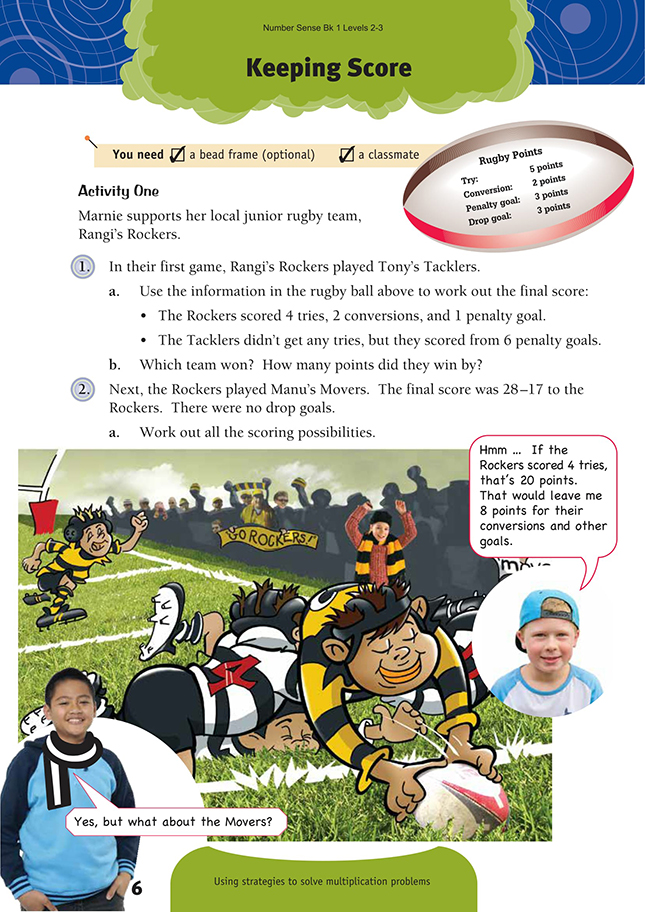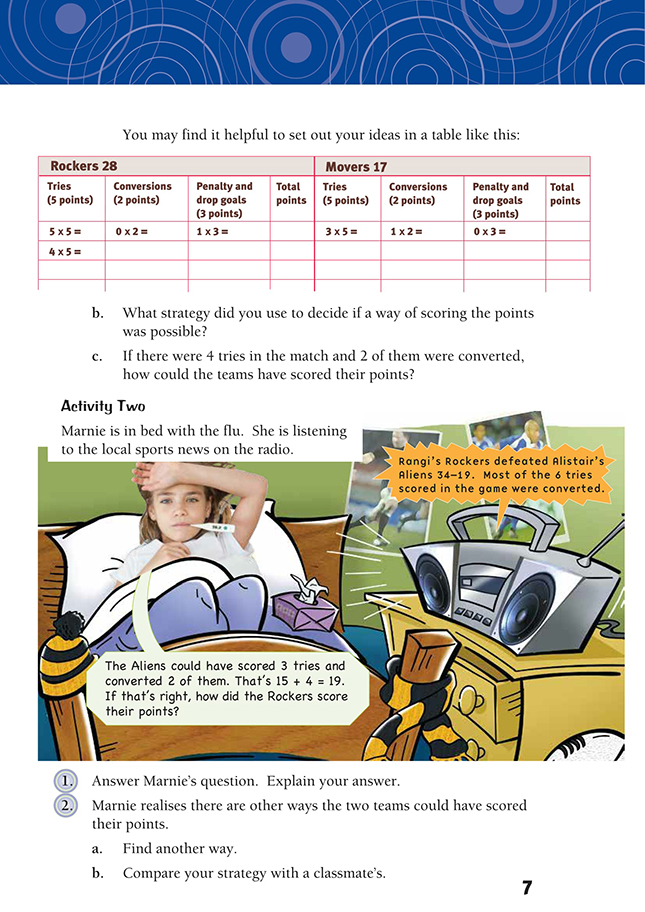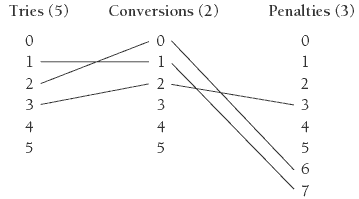This is a level 3 number activity from the Figure It Out series. It relates to Stage 6 of the Number Framework.
A PDF of the student activity is included.
Click on the image to enlarge it. Click again to close. Download PDF (452 KB)
use basic facts and mental strategies to solve multiplication problems
Number Framework Links
Use these activities to:
• encourage transition from early additive strategies (stage 5) to advanced additive strategies (stage 6) in the operational domain of multiplication and division
• help the students who are beginning to use advanced additive strategies (stage 6) to become confident at this stage in the operational domain of multiplication and division
• help your students to consolidate and apply their knowledge of basic facts.
A bead frame (optional)
FIO, Levels 2-3, Number Sense and Algebraic Thinking, Book One, Keeping Score, pages 6-7
A classmate
The context of rugby scores allows students to develop early multiplicative strategies and use a combination of multiplication and addition in recording equations. The range of combinations that the students need to test to solve the problems encourages systematic recording and reinforces the value of persistence in problem solving.
To do these activities, the students need to be able to recall their basic facts unless you allow them access to a tables chart. They also need to understand the term “converted try” in rugby scoring. (After a team scores a try, they get an extra 2 points if their kicker successfully kicks a goal, that is, converts the try.)
Activity One
With a guided teaching group, use question 1 to evaluate the students’ understanding of the scoring system used in rugby. (For example, some recent immigrants may not be familiar with the game.) Also evaluate their approach to organising the scoring data. Is it systematic? Do they need help in setting out the data? You could offer suggestions such as using tables, systematic listing, or writing equations.
In question 1, a bead frame with its fives patterns is ideal for showing the score mounting as the students add the parts. The Rockers’ score would be made by moving 4 lots of 5 beads and 2 lots of 2 beads and then adding on 1 lot of 3 beads. This shows that the final score is 27.
Question 2 provides a good model for a table. A possible table is shown in the Answers. Another variation is this matrix table:
Encourage the more able students to record all their working in one equation, for example, 5 x 5 + 1 x 3 = 28. This will enhance their understanding of equations. You could also use this as an opportunity to discuss some basic order of operations rules (for example, multiplication before addition). Ask the students to explain a mental strategy for working out their equations.
Question 2a will challenge most students to find an approach that is systematic. Direct the students to the table and ask them how they can use it to test different combinations in a sensible order. Have the students think about the total to see if it gives them some hints to start with. They may be able to use the divisibility patterns as clues. Encourage them to use statements such as: “A total that ends in 5 or 0 can be made with tries” or “An amount that can be divided by 3 can be made
with penalty goals.”
Question 2c asks students to sift through the possibilities for both teams and find combinations that work. Because there are only three possibilities for the Movers, the students would find it easiest to work through these one at a time, seeing if they can match each possibility with a Rockers combination to give the desired result.
Activity Two
This activity extends the challenge by leaving the number of tries each team scored open but relative to each other. Encourage the students to try to improve their strategy to test all the possibilities. A number of reporting-back sessions may be necessary as the students try and examine ideas.
Extension
There are other sports that use a variety of ways to accumulate points. For example:
What combination of scoring shots are possible for a batter playing cricket to score 25 runs?
In what ways can a darts player score 18 points by throwing 3 darts?
In basketball, there are 1-point, 2-point (free throws), and 3-point shots. How might a player score 14 points?
Answers to Activities
Activity One
1. a. The final score was 27–18. (5 + 5 + 7 + 7 + 3 = 27 or 5 x 4 + 2 x 2 + 3 = 27. 6 x 3 = 18)
b. The Rockers won by 9 points.
2. a. Tables can be set out in different ways. The table on the following page shows how the total score could be made up.
b. Strategies will vary. The most useful strategy is to add up the points for a given number of tries and see if you can make up the difference with conversions and penalty or drop goals. You might find it helpful to use a diagram like the one below. Start with 0 tries and see if you can score 28 from penalties only. Then use 1 try and see if you can score the remaining 23 points from a conversion and penalties. Trace a path for each option that works. For example:
c. There are three possibilities: Rockers 3 tries, 2 conversions, 3 penalty or drop
goals (15 + 4 + 9) and Movers 1 try, 4 penalty or drop goals (5 + 12); Rockers 2
tries, 6 penalty or drop goals (10 + 18) and Movers 2 tries, 2 conversions, 1 penalty or drop goal (10 + 4 + 3); Rockers 1 try, 1 conversion, 7 penalty or drop goals
(5 + 2 + 21) and Movers 3 tries and 1 conversion (15 + 2).
Activity Two
1. To make up the 6 tries and at least 2 more conversions, the Rockers could have scored 34 points through 3 tries, 2 conversions, and 5 penalty or drop goals. (15 + 4 + 15 = 34). Here is a possible strategy: If the Aliens scored 3 tries and converted 2 of them, that leaves 3 tries for the Rockers.
The Rockers must have converted at least 2 of their tries because more than half of all the tries were converted. If we check out the possibilities, we find:
• 3 converted tries is 7 x 3 = 21 points. 34 – 21 = 13. 13 is not exactly divisible by 3, so this isn’t possible.
• 2 converted tries and 1 unconverted try is 2 x 7 + 5 = 19, and 34 – 19 = 15. This is 5 penalty or drop goals, so this is possible.
2. a. Three other ways are:
Rockers 4 converted tries and 2 penalty or drop goals (28 + 6 ) and Aliens 2 tries and 3 penalty or drop goals (10 + 9); Rockers 2 unconverted tries, 3 converted tries, and 1 penalty or drop goal (10 + 21 + 3) and Aliens 1 converted try and 4 penalty or drop goals (7 + 12); Rockers 2 converted tries, 1 unconverted try, and 5 penalty or drop goals (14 + 5 + 15) and Aliens 2 converted tries and 1 unconverted
try (14 + 5).
b. Strategies will vary. These could include the use of tables and trial and improvement. Most will include dividing by 3 the points remaining after tries and conversions.




